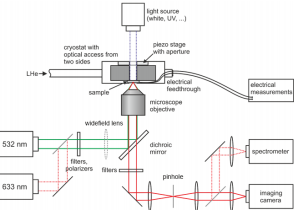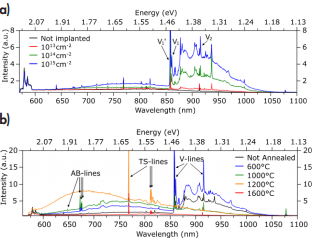Resources
 Part of the Oxford Instruments Group
Part of the Oxford Instruments Group
Expand
Collapse
 Part of the Oxford Instruments Group
Part of the Oxford Instruments Group
 Fig. 1: Optical setup
Fig. 1: Optical setup
Defect centers in silicon carbide (SiC) capable of visible and near-infrared luminescence (color centers) have attracted great attention in recent years due to their potential role for novel quantum technology (e.g. [1]). We study the creation of color centers by proton implantation and subsequent annealing under different annealing conditions. The color centers are monitored using sub-bandgap photoluminescence (PL) in a wide optical range. Particularly, we show the creation and annihilation of spectral lines related to the silicon vacancy (VSi) defect and the carbon vacancy anti site (CSi-VC) defect (Fig. 2).

Fig. 2: (a) Ensemble PL spectra of the four implantation areas directly after proton implantation. The intense signature from about 575 nm to 590 nm corresponds to the Raman-shifted excitation laser. (b) Ensemble PL spectra of the 1015 cm-2 proton-implanted area for different annealing temperatures. The three main PL signatures are indicated.
For our measurements we use a custom low-temperature confocal fluorescence microscope setup which is shown in figure 1. The sample is mounted on a piezo stage in a liquid helium flow cryostat. The sample is excited by a frequency doubled Nd:YVO4 laser (532 nm). The PL spectrum is then recorded by an Andor Shamrock SR-500i-B2 spectrograph in combination with an open-electrode CCD detector (Andor Newton DU920P-OE). This enables us the detection and spectral analysis of local PL in the visible and nearinfrared regime.
We use high-purity semi-insulating 4H silicon carbide (HPSI 4H-SiC) from CREE. At first, epitaxial graphene is grown at 1675 °C under argon atmosphere in order to prevent the formation of blinking defects at the sample surface and to reduce initially present intrinsic defects by the thermal treatment. Subsequently, a proton implantation (350 keV) is performed with various implantation doses in order to create intrinsic color centers. Afterwards, ensemble PL measurements are carried out at 3.5 K on each implantation area. Then, the sample is sequentially annealed at temperatures from 200 °C up to 1600 °C for 30 min and the PL measurement is repeated after each annealing step.
With the setup described above it is possible to locally record PL spectra. We analyze the intrinsic defects in SiC and their evolution with different annealing temperatures. Figure 2a shows the PL spectrum of the four implantation areas directly after proton implantation, figure 2b the PL of the area with highest implantation dose after annealing at different temperatures. The signature of silicon vacancy defects (VSi) are visible in all spectra (V-lines) [2]. Other signatures like the ABlines, which are characteristic for the carbon vacancy anti site pair (CSi-VC) [3], and the TS-lines (temperaturestable defect), which is not yet reported (to the best of our knowledge), emerge only after annealing.
In contrast to the TS-lines, V-lines and AB-lines are strongly reduced after annealing at higher temperatures. It is reported that VSi is metastable and can be transformed into CSi-VC at sufficiently high annealing temperatures [1, 4].
In the PL spectra, this transformation goes along with a reduction of the V-lines and an increase of the AB-lines at annealing temperature around 800 °C to 1000 °C. At even higher annealing temperatures, we observe a potential subsequent transformation process where the AB-lines disappear while the TS-lines increase dramatically. We therefore conclude that the TS-lines are caused by a defect which is a further transformation product of the CSi-VC defect.
The study of sub-bandgap PL on implantation-induced defects in SiC and its evolution with annealing temperature provides us valuable insight in their origin and stability. As a next step, we will reduce the density of color centers to single observables defects, which are extremely interesting for quantum applications. Furthermore, we will add an Andor iDus InGaAs detector array to our Shamrock 500i spectrograph to extend our spectral detection range further in the near-infrared regime. Defects with PL around 1600 nm are of wide interest as they can be used as single photon sources near the telecom wavelength.
[1] S. Castelletto, B. C. Johnson, V. Ivády, N. Stavrias, T. Umeda, A. Gali and T. Ohshima, nature materials 13, 151-156 (2013)
[2] E. Janzén, A. Gali, P. Carlsson, A. Gällström, B. Magnusson and N.T. Son, Physica B 404, 4354–4358 (2009)
[3] J. W. Steeds, Physical Review B 80, 245202 (2009)
[4] M. Bockstedte, A. Mattausch and O. Pankratov, Physical Review B 69, 235202 (2004)
Date: September 2017
Author: Prof. Dr. Heiko B. Weber, Chair of Applied Physics, Department of Condensed Matter Physics, University of Erlangen-Nuremberg (FAU)
Category: Application Note
